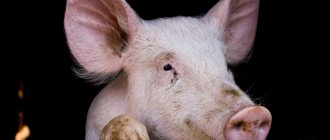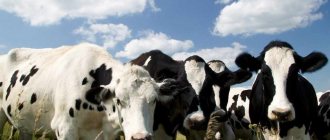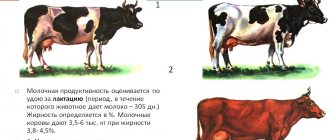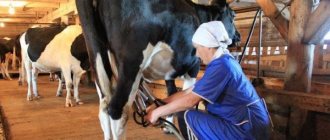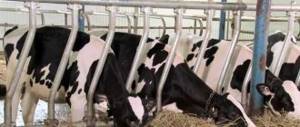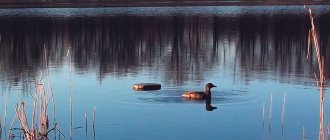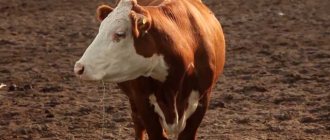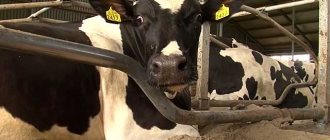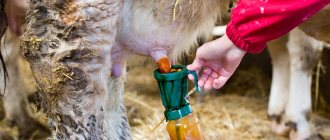When starting to consider the issue of heat in cows, it is worth noting that identifying this particular phenomenon is the basis for ensuring normal reproduction of animals, since it allows for effective insemination. The very fact of insemination is difficult to overestimate - any owner, not to mention specialists at livestock enterprises, knows that timely insemination of a cow, followed by pregnancy and calving, is not only a way to produce offspring, but also has a decisive influence on milk productivity in general, the amount of milk received per lactation and basic economic indicators, such as total milk yield, feed costs, etc.
Sexual cycle
Almost all processes occurring in the body are subject to a certain cyclicity: division, aging and death of somatic cells; absorption of food, its digestion, extraction of nutrients and elimination of undigested residues, gas exchange processes during respiration and much more. The sexual sphere of animals in general and cows in particular is no exception to this rule, and understanding the principles of the sexual cycle and the changes that occur in the female’s body at its different stages is one of the most important issues in reproductive science.
In the sexual cycle, which is an extremely complex reflex process and is accompanied by a number of chemical and biological changes in the body of a non-pregnant female, there are several stages that smoothly transition into each other and have different characteristics:
- Excitation.
- Braking.
- Balancing.
In animal breeding, the main role is played by the stage of arousal in the cow, since effective insemination is possible only during this period. The instinct of procreation, which manifests itself most clearly at the stage of excitement, is so strong that it often suppresses such powerful reflexes of animals as feeding or the instinct of self-preservation. The excitation stage itself includes four so-called phenomena:
- estrus;
- sexual arousal;
- hunting;
- ovulation.
Sexual cyclicity begins with the onset of puberty in the heifer and continues throughout life, right up to the climacteric period, characterized by the extinction of the reproductive functions of the body. It is also worth remembering that puberty almost always occurs earlier than physiological maturity. Thus, heifers become ready for reproduction already at 6-9 months, however, insemination at this age leads to underdevelopment of the animal, producing a weak and low-viability offspring, and increases the risk of pathological birth. The first insemination of heifers is carried out at the age of 13-16 months, paying attention to the general constitution of the animal. According to experts, by the time of the first insemination, the heifer must reach at least 70% of the weight of an adult animal characteristic of a particular breed.
Sexual cycle in cattle
Stages of the reproductive cycle: there are 3 stages:
Excitation, inhibition, balancing 1. stage Excitation - consists of 4 phenomena a) Estrus - characterized by the release of mucus from the female genital organs, proliferative processes, hyperemia and swelling of the mucous membrane, the cervix opens slightly, mucus flows out - self-cleaning of the female genital tract occurs. B) General sexual reaction - characterized by a change in the behavior of the female, increased motor activity, they show anxiety, anger, decreased productivity and appetite, show interest in the male, jump, but are not allowed to mount. C) Hunting is a positive sexual reaction to a male, a certain position (the cow is standing), allowing coitus. D) Ovulation is the process of rupture of a mature follicle and release of an oocyte.
2. Inhibition stage - weakening of the excitation stage. 3. stage of Equalization, the extinction of all phenomena occurs in the reverse order, stabilization of physiological processes in the body and reproductive system. Clinical problems of the reproductive cycle. Sexual cycles are classified according to their manifestation: 1. Full - if all phenomena are manifested; 2. Inferior - when 1-2 phenomena fall out. If the phenomenon occurs: A) Estrus - aestrous sexual cycle B) Arousal - areactive; B) the phenomenon of Hunting is alibid; When these three phenomena disappear, it indicates a lack of estrogen hormones and manifests itself as “Silent hunting.” D) OVULATION - anovulatory sexual cycle, when it falls out, we can talk about a lack of luteinized hormones - there is a shortening of sexual cycles - this happens with CYSTS. Sexual cycles are: 1. Synchronous - when all phenomena appear in order; 2. Asynchronous - the manifestation of individual phenomena is delayed and is clinically manifested by metrorrhagia 2-3 days after the end of the hunt.
Visual assessment of lochia on the 7-8th day after the birth period.
| 1 State GENITAL ways | Daily volume of lochia, ml | Color | Smell | Consistency Uniformity | |
| 1 | 2 | 3 | 4 | 5 | |
| Normal | 100-150 | Light chocolate | Without smell | Thick | Homogeneous 1 |
| Postpartum endomitritis | 200-300 | Gray-red | Without smell, at necrotic meter - ichorous | Semi-liquid | Heterogeneous with cereal and veined pus |
| Subinvolution of the uterus | 300-400 | Dark red | Without smell | Thick | Heterogeneous |
SEXUAL HUNTING IS ABSENT in case of: 1) hypofunction of the ovaries; | 2) persistent corpus luteum; I 3) luteal cyst. PRESENT regularly in: 1) salpingitis; 2) chronic latent endometritis. not regularly I. with decreasing interval for: follicular cyst. P. with an increase in the interval with: delayed ovulation; chronic purulent endometritis.
Estrus
It is characterized by the secretion of mucus from the labia (transparent at the beginning and cloudy at the end of estrus). The secretion of mucus occurs as a result of proliferation of the mucous membrane of the birth canal, its hyperemia, swelling and increased secretion of the glands of the uterus and vagina.
At this moment, the cervix dilates, the degree of which can be used to judge the beginning, middle or end of estrus. The cloudiness of the secreted mucus towards the end of estrus is associated with the rejection of epithelial cells in the birth apparatus. Sometimes the mucus takes on a reddish tint or streaks of blood can be seen in it. This phenomenon is not a pathology and is associated with damage to excessively blood-filled endometrial vessels. The normal duration of estrus in cows is from 2 to 5 days.
Sexual arousal
Sexual arousal is a general reaction and serves as a harbinger of an approaching hunt. As a rule, it is the cow’s sexual arousal that makes it possible to notice that the timing of possible insemination is approaching. At this moment, the animal becomes restless, often refuses food, and reduces milk production. In a state of sexual arousal, cows often moo loudly; when kept in loose housing, they jump on other cows and behave in an unusual way. At the same time, at the stage of sexual arousal, the cow does not allow the male to mount, and insemination at this moment, as a rule, does not produce results, since the sperm introduced into the female’s birth canal will simply die before ovulation.
Sexual arousal occurs 1-1.5 days after the start of estrus, and changes in the animal’s behavior are associated primarily with an increase in the concentration in the blood of the follicular hormone responsible for the development of sexual heat.
Female reproductive cycle and its regulation
Sexual cycle
(sexual periodicity) of females is a complex of physiological and morphological processes occurring in her body during the period from the beginning of one estrus and heat to the next.
Sexual cycles appear with the onset of puberty in different species of animals at different times and are repeated at strictly defined intervals until old age.
According to the behavior of the female, the reproductive cycle is divided into two main stages: one is estrus and sexual heat, the other is the inter-estrus period or sexual rest.
In some animal species (mares, cows, pigs), sexual cycles are rhythmic, repeated from the onset of puberty until menopause, and are absent only during pregnancy. Animals in which the sexual cycle is repeated many times during the year and in a certain rhythm are called polycyclic. The sexual cycle of polycyclic animals is characterized by relatively identical and short phases.
Some animal species (dogs, cats and most wild animals) experience one or two, rarely three, sexual cycles during the year. Such animals are called monocyclic, dicyclic, tricyclic.
A characteristic feature of the sexual cycle of monocyclic animals is the duration of sexual rest. In other animal species (sheep, goats, camels, buffaloes), the rhythm of the sexual cycle is observed only during a certain period of time, most often in spring or autumn. Between periods of sexual activity there is a long period of sexual rest. Such animals are polycyclic, but have a sexual season.
The duration of the sexual cycle and its individual stages varies among different animal species. In a cow, the average duration of the sexual cycle is 18-21 days with fluctuations of 12-30 days. In sheep - 17 days (14-19), in pigs - 19-21 days (11-30), in horses - 20-22 days (10-36).
The female reproductive cycle can be divided into 4 stages: proestrus (before heat), estrus (heat), metaestrus (after heat) and diestrus (not in heat). According to nervous processes, the sexual cycle is divided into 3 stages: excitation, inhibition and balancing:
the arousal stage is characterized by the growth of cells in the genital organs of females, especially the mucous membrane of the uterus and oviducts; in the ovaries, the follicles increase, the concentration of follicular hormones increases. Under the influence of estrogen hormones, the blood vessels supplying the reproductive apparatus dilate, causing the mucous membrane of the oviduct, uterus and vagina to become redder, swollen, and alternating contraction and relaxation of the muscle layers of the horns, body and cervix are observed. The vulva also becomes red, swollen and swollen. The secretion of the mucous membrane of the uterus, vagina and cervix increases significantly. The mucus in the cervical canal liquefies and flows out. All these changes in the function of the reproductive organs, especially the mucous membrane and its glands, are called estrus. At this time, under the influence of estrogen hormones that enter all tissues through the bloodstream, the excitability of the nervous system increases, the female’s sexual arousal increases, she becomes more mobile, restless, and sometimes refuses to feed.
The female allows the male to approach her (immobility reflex) and strives for him herself. The manifestation of a female’s peculiar behavior, characterized by a desire for a male and readiness to mate, is called sexual heat. This is the optimal time period for natural and artificial insemination. Sexual heat in females occurs much later than the start of estrus. In cows 15-20 hours after the onset of estrus, in pigs after 12-15 hours, in horses the phenomenon of estrus is much less pronounced than in cows.
Increased blood flow to the genitals, growth and secretion of cells of the uterine mucosa during this period are, as it were, preparation for fertilization of the egg.
At the end of the first or beginning of the second day from the start of heat, ovulation occurs in cows; in sheep, pigs and mares, ovulation usually occurs 20-40 hours after the start of heat. For fruitful insemination of a female, it is necessary to have a full-fledged estrus, heat and ovulation.
Ovulation
- rupture of the follicle under the pressure of the accumulating follicular fluid and the release of the egg and follicular fluid. In cows, sheep, pigs and rabbits, follicle rupture occurs over the entire surface of the ovaries. The horse's ovary is covered with a dense membrane, and the follicles rupture only in the area of the ovulation fossa. In female farm animals, ovulation occurs spontaneously, that is, regardless of the meeting of the female with the male;
stages of inhibition (metaestrus). After ovulation, the female’s sexual activity (earlier in cows) gradually fades away. At the site of rupture of the ovarian membrane and blood vessels, hemorrhage occurs into the empty cavity of the follicle. The follicular marks begin to grow and in their place the corpus luteum develops - a temporary gland that secretes the pregnancy hormone (progesterone). If fertilization does not occur, then cell growth and secretion of the genital organs gradually stop;
equilibration stage (diestrus). At this time, the process of involution of the reproductive system occurs - its return to the state before estrus and hunting. 12-15 days after ovulation, in the absence of pregnancy, the release of progesterone gradually stops, and the cells of the corpus luteum degenerate. The processes of follicle maturation are activated again and a new sexual cycle begins.
The duration of sexual cycles, as well as the timing of estrus, heat, and the time of ovulation in females of different animal species are different.
The occurrence of sexual periodicity, especially the timely manifestation and duration of heat and estrus, and the processes of ovulation are significantly influenced by environmental conditions (temperature, feeding, maintenance).
In the process of natural selection, sexual cyclicity in many wild animals is seasonal. In farm animals, when kept indoors and provided with feed all year round, sexual seasonality is smoothed out.
Estrus and heat in sheep and pigs can occur 2-4 weeks after birth; in most sheep and pigs it appears shortly after the lambs are slaughtered and the piglets are weaned. However, the onset of heat in them, like in cows, also depends on certain climatic and feeding factors, and housing conditions.
If you find an error, please select a piece of text and press Ctrl+Enter.
Hunting near cows
Hunting is a specific phenomenon, since its very essence is a positive reaction of a cow to a male. It is impossible to detect or see heat, since only estrus and sexual arousal are obvious. It is possible to detect heat in a cow only with the help of a test bull or a full-fledged male, or by approximately calculating the onset of this stage based on visible signs.
The hunt consists of the fact that the cow not only tries to get closer to the bull, but also allows him to mount. Sperm introduced into the birth canal at this time maximizes the chance of fertilization of the egg and the successful development of pregnancy.
At this time, the cow arches her back, lifts her tail and moves it to the side, frequent urination in small portions, and contractions of the labia are noted. Shortly before the end of the heat, the cow's body temperature drops by 1-1.5°C.
Hunting for different representatives of cattle has a different time duration and can range from 3 hours to a day and a half.
